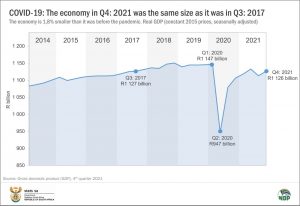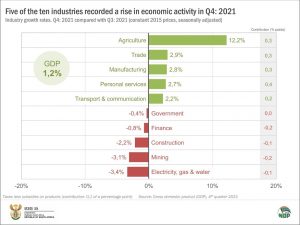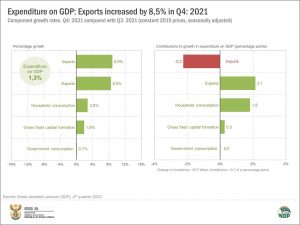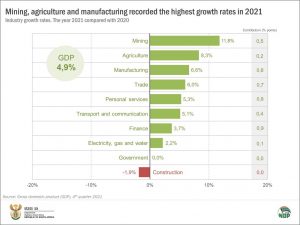The South African economy records a positive fourth quarter
Real gross domestic product (GDP) grew by 1,2%1 in the fourth quarter (October–December), taking the annual growth rate for 2021 to 4,9%.
The fourth quarter was upbeat, with personal services, trade, manufacturing and agriculture the key drivers of growth. An increase in demand for goods and services drove up the expenditure side of the economy, with exports and household expenditure the most significant contributors to growth.
Despite these positive figures, real GDP has yet to recover to the level recorded in the second quarter of 2021, before civil unrest and stricter lockdown restrictions shook the economy in the third quarter.2
Real GDP continues to lag pre-pandemic levels too, with economic activity on par with the third quarter of 2017. The economy is 1,8% smaller than it was in the first quarter of 2020.
GDP production: personal services, trade, manufacturing and agriculture take the lead
Personal services, trade, manufacturing and agriculture were the most significant positive contributors to growth in the fourth quarter. Personal services, which includes health-related activities, continued to register increased activity stemming from the national vaccination programme. Various hospitals also recorded a rise in non-COVID-19 related patient admissions in the fourth quarter.
Trade activity increased by 2,9% as lockdown restrictions eased, with positive results from retail; motor trade; tourist accommodation; and restaurants, fast-food and catering. Economic activity in the wholesale sector, however, edged slightly lower.
The 2,8% rise in manufacturing output was mainly driven by the production of petroleum, chemical & plastic products and food & beverages. All other manufacturing divisions posted positive results too, with the exception of metals & machinery and furniture & ‘other’ manufacturing that performed poorly.
Good rains during the season helped boost agriculture activity. Together with a rise in animal products – such as cattle, sheep, pigs and poultry – increased wheat production lifted the industry by 12,2%.
The higher than usual rainfall was good for agriculture, but not great for mining. The country produced less iron ore and coal in the fourth quarter, with heavy rains disrupting operations at opencast mines.
Miners of gold, manganese ore, diamonds and chromium ore also recorded lower production figures.
The finance industry edged lower by 0,8%. Financial intermediation (excluding insurance) and auxiliary activities recorded a decline in economic activity.
The electricity, gas and water supply industry was down 3,4%, with production hampered by load shedding and infrastructure problems that affected both electricity and water distribution.
Increased demand boosts expenditure on GDP
Exports increased by 8,5% in the fourth quarter, driven mainly by precious metals and stones (gold, platinum and diamonds); base metals; and motor vehicles, parts & accessories. Imports were up too, on the back of increased demand for machinery & equipment; motor vehicles, parts & accessories; and base metals.
Consumer demand recovered in the fourth quarter, with household expenditure rising by 2,8%. Reflecting the rise in trade activity on the production side of the economy, households increased spending across all product categories. The largest positive contributors to household expenditure were food & non-alcoholic beverages, restaurants & hotels, and furnishings & household equipment.
Inventories were a drag on the expenditure side in the fourth quarter. Even though there was an increase in supply, brought about by a rise in production and imports, the trade and manufacturing industries had to dig into their stockpiles to meet demand.
Mining, agriculture and manufacturing the top performers in 2021
The fourth quarter results allow us to reflect on the calendar year as a whole. After a dismal 2020, which saw the economy contract by 6,4%, economic activity increased by 4,9% in 2021. Mining, agriculture and manufacturing recorded the highest growth rates in 2021, with finance, personal services and manufacturing the largest positive contributors to overall growth.
The construction industry contracted in 2021, falling by 1,9%. This was the fifth consecutive year of decline in construction.
For more information, download the Q4: 2021 GDP statistical release and media presentation here.
1 The quarter-on-quarter rates are seasonally adjusted and in real (volume) terms (constant 2015 prices). This is Stats SA’s third GDP statistical release after the completion of its latest benchmarking and rebasing exercise. More information on this exercise is available here. Note that Stats SA no longer uses the annualised rate as the headline growth rate.
2 Stats SA, Third wave of COVID and civil disorder pummel economy as GDP falls by 1,5% (read here).
Similar articles are available on the Stats SA website and can be accessed here.
For a monthly overview of economic indicators and infographics, catch the latest edition of the Stats Biz newsletter here.





